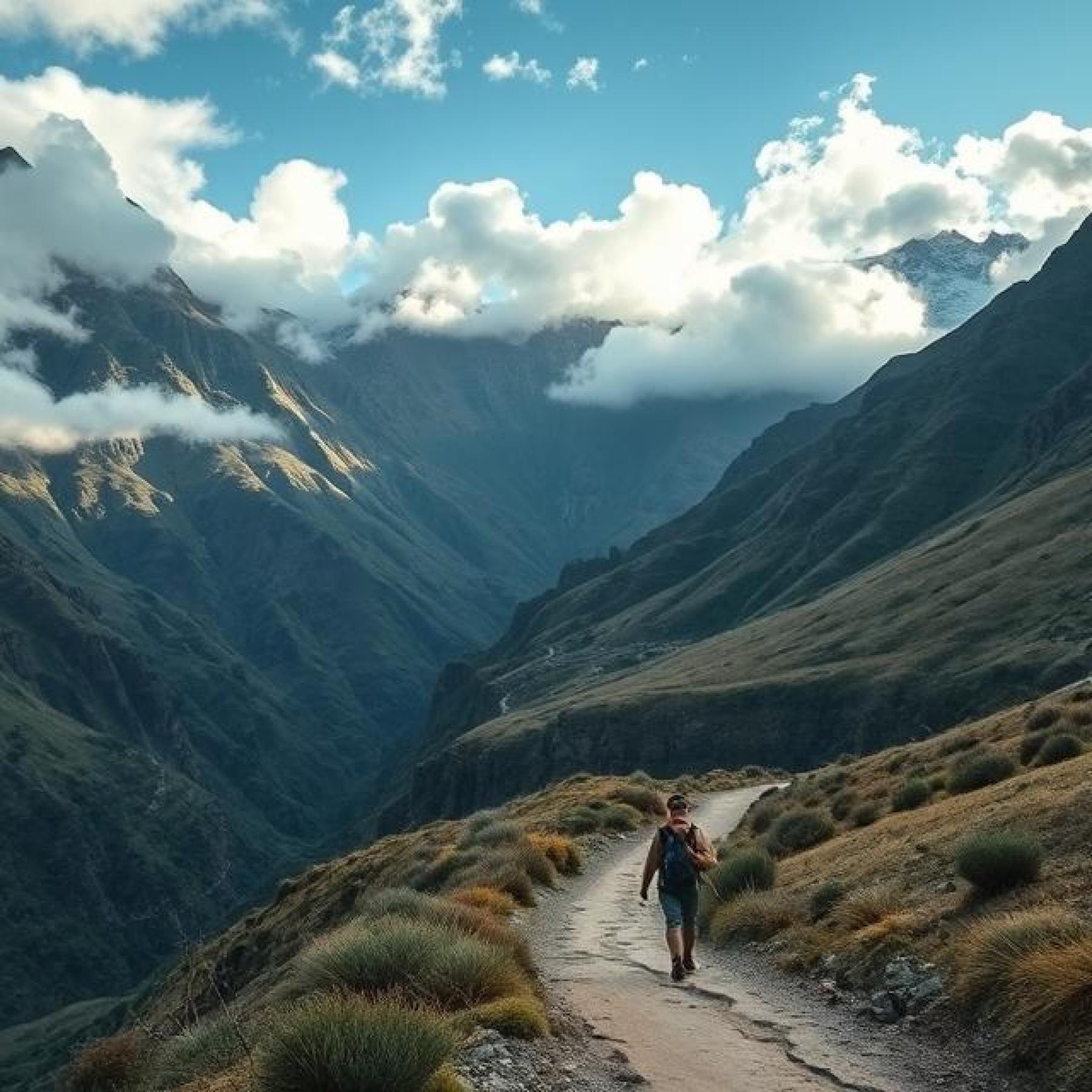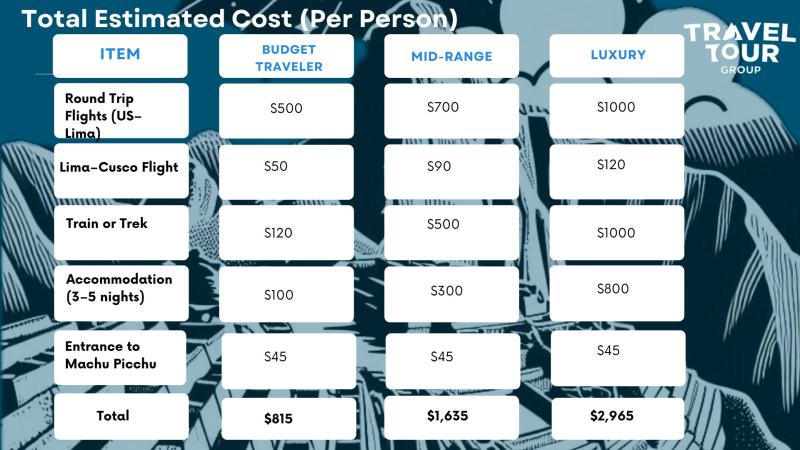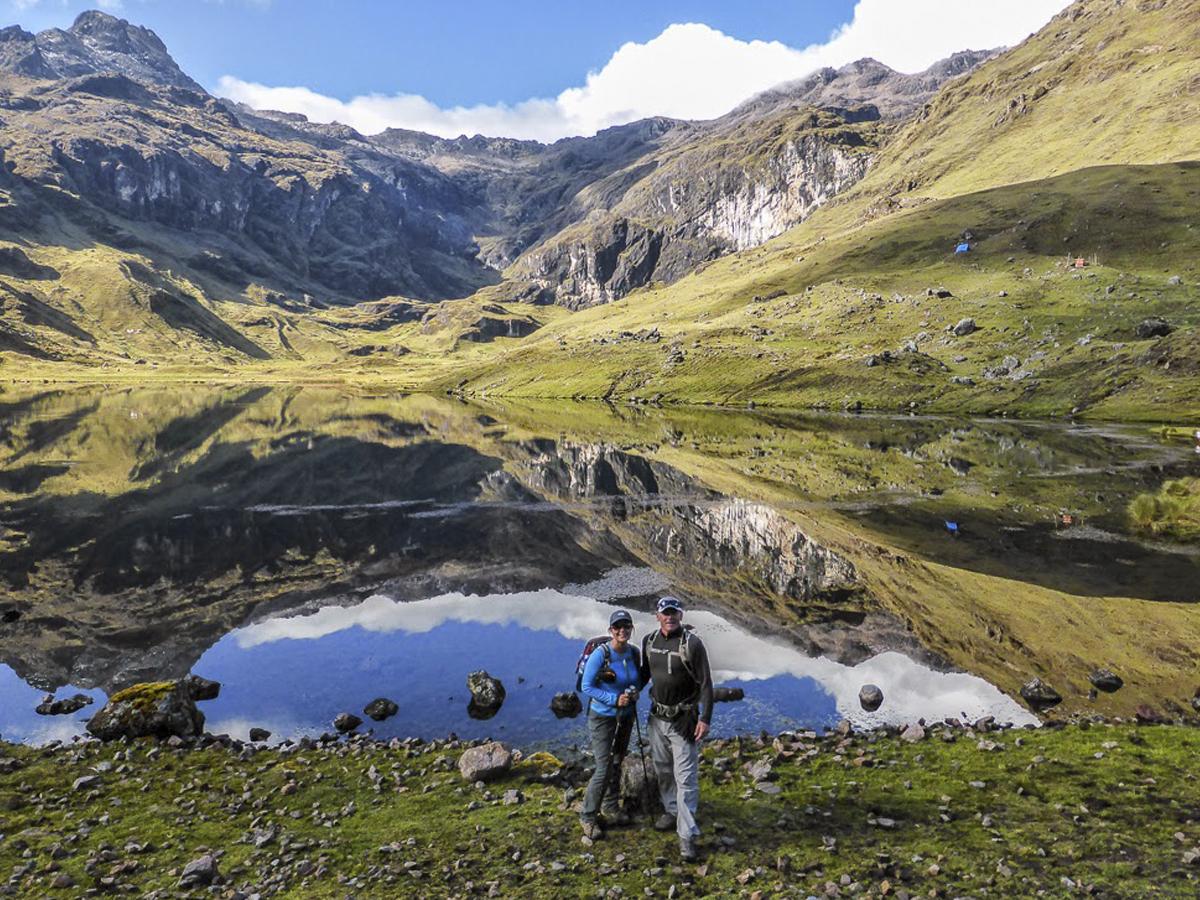Traveling from the US to Machu Picchu

Many American travelers aspire to visit Machu Picchu. Whether you're seeking adventure or interested in history, this iconic destination in Peru is worth the trip. I am pleased to present this comprehensive guide to traveling from the United States to Machu Picchu. It will cover all necessary information, including flights, transfers, costs, and practical tips.
Step 1: Book Your Flight to Peru
Fly to Lima (Jorge Chávez International Airport)
Main Entry Point: All international flights from the US land in Lima, Peru’s capital.
Top Departure Cities (Nonstop or 1 stop):
- Miami (MIA)
- New York (JFK)
- Los Angeles (LAX)
- Atlanta (ATL)
- Dallas (DFW)
Airlines that offer service: LATAM, American Airlines, Delta, JetBlue, United.
- Flight Cost (Round Trip)
- Economy: $400–$900 USD (depending on season and city)
You'll have about 7 to 10 hours for your trip, and you'll be able to relax and enjoy the journey with layovers along the way.
Here's a helpful tip: If you're looking for the best deals, it's always a good idea to book at least 2–3 months in advance.
Step 2: Domestic Flight from Lima to Cusco
Once you arrive in Lima, you'll need to take a domestic flight to Cusco.
- Hey, just so you know, the flight time is about an hour and a quarter.
- Airlines: LATAM, Sky Airline, and JetSMART!
- The cost is between $40 and $120 USD for one-way.
Recommendation: We know how hectic traveling can be, but we want you to have the best experience possible. Please allow at least a 3-hour layover in Lima so you have plenty of time to clear immigration, collect your baggage, and check in for your domestic flight.
Step 3: Travel from Cusco to Machu Picchu
There are two main ways to reach Machu Picchu from Cusco, and we're here to help you choose the best one for you!
Option A: Take the Train (Most Comfortable)
Route: Cusco → Ollantaytambo → Aguas Calientes
- Step 1: Private transfer or shared bus to Ollantaytambo (1.5–2 hours)
- Step 2: Train from Ollantaytambo to Aguas Calientes (~1.5 hours)
- Step 3: Short bus to Machu Picchu ruins (30 min)
Train Operators: PeruRail, Inca Rail
Train Ticket Cost:
- Expedition class: $60–$80 USD (one-way)
- Vistadome (panoramic): $80–$120 USD
Option B: Trekking Options (Adventure Seekers)
- Classic Inca Trail (4 days): $700–$900 USD (permit required)
- Salkantay Trek (5 days): $500–$800 USD
- Short Inca Trail (2 days): $450–$600 USD
Tip- Permits for the Inca Trail are a hot commodity, so it's always best to book well in advance to ensure you have the opportunity to experience this amazing trail!
 |
How to Travel from the US to Machu Picchu |
Traveling from the US to Machu Picchu is a multi-step journey, but I'm here to tell you that it's absolutely worth the effort! Whether you're looking for a scenic train ride or an epic multi-day hike, planning ahead will make your trip smoother and more affordable. Hey, my friend, I've got some great advice for you: book early, pack smart, and get ready to check off one of the world's most iconic travel destinations from your bucket list!
Best Seasons to Travel from the USA to Machu Picchu: When to Go and Why
Learn about the best times to visit Peru's iconic wonder, along with useful information about the weather, crowds, and prices.
Understanding Machu Picchu’s Seasons Peru has two main seasons:
- Dry Season (May to September)
- Rainy Season (October to April)
Machu Picchu is located in a subtropical cloud forest, so the weather can be unpredictable. However, understanding these weather patterns can greatly improve your experience.
Dry Season: May to September (Peak Travel Time)
- Best For: There will be clear skies, hiking, and photography.
- Watch Out For: More people and higher prices.
The dry season sees the most visitors to Machu Picchu. From late May through early September, the weather is sunny and dry, making it a great time to hike the Inca Trail or Salkantay Trek, or simply to explore the ruins.
June, July, and August are the busiest months. This is because it is summer vacation time in the U.S. and Peru's winter. Tickets for the Inca Trail and Machu Picchu entry can sell out months in advance, so it's best to book early.
Here's a helpful tip: If you want to avoid large crowds but still enjoy dry weather, plan your trip for May or early September.
Rainy Season: October to April (Low Season)
- Best For: If you're on a budget and want to avoid crowds, this is the place for you.
- Watch Out For: There is heavy rain, and the trails are closed.
The rainy season brings lush landscapes and fewer tourists. While it might rain, especially in January and February, you can still visit Machu Picchu. The site itself is open all year, but the Inca Trail closes in February for maintenance.
If you don't want to hike and want to experience Machu Picchu without the crowds, late March or April is a good option.
Note: During this season, be sure to have waterproof gear and travel plans that can change if necessary.
Best Time by Travel Preference
| Travel Style | Ideal Months | Reason |
| Hikers | May to September | Best trail conditions and mountain views |
| Budget Travelers | March, April, October | Lower airfare and hotel prices |
| Lower airfare and hotel prices | May, June | Clear skies, golden light |
| Avoiding Crowds | April, September | Fewer tourists but decent weather |
Should You Go?
The best time to travel to Machu Picchu from the USA depends on what matters to you. If you want dry weather and great hikes, book your trip during the dry season. If you're flexible and want to save money, think about traveling in the shoulder months of spring or fall.
No matter when you go, Machu Picchu is an unforgettable experience. Just be sure to plan ahead and pack for anything.
Additional Tips:
Before you pack your hiking boots and buy your train ticket to Aguas Calientes, there are some important things you need to know about travel requirements and safety tips.
Do U.S. Citizens Need a Visa to Travel to Peru?
Good news!
If you have a U.S. passport, you don't need a visa to visit Peru as a tourist.
- You can stay in Peru up to 90 days.
- Make sure your passport is valid for at least 6 months after the date you enter the country.
- Immigration officials may ask for proof of how you will get back to your home country. This could be a return ticket.
tips: Don't stay in the country longer than 90 days. If you do, you might have to pay a fine when you arrive back at the airport.
Are Vaccines Required for Peru or Machu Picchu?
No mandatory vaccines are required to enter Peru.
However, the CDC and WHO recommend the following for most travelers:
- Hepatitis A
- Typhoid
- Tetanus & Diphtheria
- Yellow Fever (only if you're visiting the Amazon jungle, like Iquitos or Puerto Maldonado)
If you're staying only in Cusco and Machu Picchu, yellow fever is not necessary.
Should I Get Travel Insurance for Machu Picchu?
Absolutely. It is highly recommended to purchase travel insurance when visiting Peru, especially for adventurous activities like hiking the Inca Trail.
Make sure your policy covers:
- Trip cancellation or delays
- Medical emergencies
- Emergency evacuation (in case of altitude sickness or injury in remote areas)
- Lost or stolen baggage
Altitude Sickness: A Real Concern
Cusco and Machu Picchu are located at high elevations:
- Cusco: It's 3,400 meters (11,150 feet) high.
- Machu Picchu is 2,430 meters (7,970 feet) high.
Many travelers experience altitude sickness (headache, nausea, fatigue). To prevent it:
- You should spend 24 to 48 hours in Cusco before going to Machu Picchu.
- Drink coca tea or chew coca leaves.
- Make sure you drink enough water.
- Don't drink alcohol on the first day.
- You should talk to your doctor about taking acetazolamide.
What to Pack for Machu Picchu and High Altitude Travel
Traveling to Machu Picchu means you will go up and down in altitude and the weather can be unpredictable. Here's what you should pack:
- Lightweight rain jacket or poncho
- Comfortable hiking shoes
- Sunscreen and bug repellent
- Reusable water bottle
- Altitude sickness medication (e.g. Acetazolamide)
- Layers of clothing (day/night temperatures vary greatly)
Currency and Payment in Peru
- Peru's official currency is the Peruvian sol (PEN).
- You can pay with U.S. dollars in some tourist areas, but it's better to carry soles.
- To get the best exchange rate, use ATMs in Cusco or Lima.
- You can use credit cards almost everywhere in cities, but in rural or remote areas, you're better off with cash.
Safety Tips for Americans Visiting Peru
Peru is usually safe for tourists, especially in places like Cusco and Machu Picchu. Still, follow these precautions:
- In Lima and Cusco, use official taxis or ride-sharing apps like Uber.
- Don't show your valuables (jewelry, expensive electronics).
- Don't walk alone at night in areas you don't know.
- Only book treks and tours with companies that are officially approved.
Entry Tickets to Machu Picchu
- Buy your Machu Picchu entrance ticket ahead of time, especially during the busy months of May to August.
- If you want to hike Huayna Picchu or Machu Picchu Mountain, book months in advance because spots are limited.
- On the day of entry, remember to carry a physical or digital copy of your ticket and passport.
Traveling from the U.S. to Machu Picchu is an unforgettable journey, but you have to prepare. If you make sure your documents, health precautions, and travel plans are in order, you'll enjoy Peru to the fullest without any unpleasant surprises.
No matter what you like, there's a great way to get to the Inca citadel. If you want to learn more about planning your trip, check out our top recommended treks:
Inca Jungle : A fun adventure that includes biking, zip-lining, and hiking through tropical landscapes.
Want to skip the hike? Our complete guide shows you how to get to Machu Picchu from the U.S. by train or bus.


